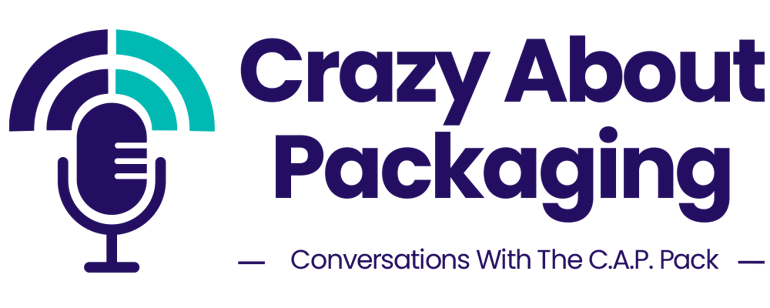
In our latest episode of the Crazy About Packaging podcast, our hosts dive into the fascinating world of modified atmosphere packaging (MAP). This episode is a must-listen for anyone interested in food packaging technology, sustainability, and how innovative solutions can extend shelf life while maintaining food quality.
Sneak Peek for Episode #19
Listen to the latest podcast to hear us discuss modified atmosphere packaging on Spotify or Apple, or watch on our website. Want a sneak peek? Read on to see some of the topics we cover.
Can I Recycle That?
We took a break from our recycling trivia game last episode, but it’s back full force with a new mystery! Natalie shows Mike and Jonathan a challenging piece of packaging: a ground turkey package that would have been used in a modified atmosphere application.
Our hosts are torn on whether the packaging can be recycled, as Natalie intentionally leaves out a vital piece of information: what material the packaging is made of. With this limited information, Mike and Jonathan weigh the factors that would determine the recyclability of the material, from possible materials and coatings to opacity and markings. The result? The guys give this one a “hard maybe” before Natalie reveals the truth. Listen to the podcast to find out whether Natalie should recycle her container or toss it in the garbage!
What is Modified Atmosphere Packaging?
First up: what is MAP? In its most simple terms, this is the process of sealing both a product and a modified atmosphere into packaging — this could include increased levels of gasses such as nitrogen to protect food from damage or slow the spoilage caused by too much oxygen.
Jonathan shares his extensive experience with MAP, detailing how this technology, initially popular in Europe, has revolutionized food packaging in the U.S. by extending shelf life and maintaining food freshness. “Modified atmosphere packaging has been around for quite a number of years,” recalls Jonathan. “If you remember, Fresh Express came out with salads in a bag. And if you just put salad in a bag — great. But what these guys did is actually use flow wrapping systems and filling systems that allowed them to insert modified atmosphere into the bag and then seal it [to preserve freshness longer].” From those beginnings, the industry welcomed modified atmosphere packaging (MAP) as a process that could preserve and protect food, extending shelf life up to three times longer than other processes.
Modified Atmosphere Packaging Applications
What is MAP most commonly used for? This process offers versatile solutions across various food categories, ensuring products stay fresh longer while maintaining their quality. Examples include:
- Case-ready meats: MAP extends shelf life from 1-5 days to 10-14 days or more, preserving the fresh, red appearance that U.S. consumers prefer.
- Bakery items like bread and pastries: Packaging prevents staleness and mold growth, keeping products soft and delicious without preservatives.
- Fresh produce: MAP maintains crispness and color of fruits and vegetables, significantly reducing spoilage and food waste.
- Snack products like chips: The cushioning effect of inert gas within MAP packaging protects crispy snacks from breaking during transport.
- Dairy products and ready-to-eat meals: MAP prevents mold growth and preserves texture and flavor, which is essential for specialty cheeses and convenient meals.
As Jonathan highlights, "MAP is a fantastic method of preserving nutrients, color, and quality of foods to extend shelf life. It’s a terrific vehicle to get that freshness to consumers." By implementing MAP, the food industry can reduce food waste, improve product quality, and offer consumers fresher, longer-lasting products, aligning with the growing demand for sustainable packaging solutions.
The Evolution and Future of MAP
Modified atmosphere packaging has evolved significantly since its inception, adapting to meet the growing demands of the food packaging industry.
Recent advancements in MAP have focused on improving material use and sealing techniques. For instance, companies are now using polypropylene trays with EVOH laminates to enhance barrier properties while ensuring recyclability — Jonathan highlights the critical role of proper sealing in maintaining the modified atmosphere, as even a tiny pinhole can compromise the entire package.
Innovations like the development of pre-padded trays and the integration of sealing systems that accommodate various contaminants have pushed the boundaries of what MAP can achieve, ensuring consistent quality and extended shelf life across diverse food products.
Looking ahead, the future of MAP is likely to see further integration of advanced materials and techniques. The continued evolution of MAP technology will ensure it remains a cornerstone of the food packaging industry, providing innovative solutions that meet both consumer demands and sustainability goals.
Join the MAP Conversation
This episode is packed with expert knowledge, practical insights, and real-world examples that illustrate the importance and effectiveness of MAP in today’s packaging industry. Whether you’re a packaging professional, a sustainability enthusiast, or simply curious about how your food stays fresh longer, this episode offers something for everyone.
For more information, visit our website. Join the conversation on LinkedIn and on Instagram and X. You can also email us at ICPG@impactgroup.co. We love hearing from our audience and look forward to your feedback.



